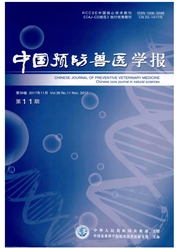

 中文摘要:
中文摘要:
为了提高表达含有猪繁殖与呼吸综合征病毒(Porcine reproductive and respiratory syndrome virus,PRRSV)GP5基因DNA疫苗的死疫效应,本研究通过人工合成的方法将GP5基因的密码子改造为猪体嗜好的密码子,并将其作为免疫原基因,连同野生型GP5基因,分别插入表达载体pIRES1neo中,构建重组质粒pIR-optiGP5和pIR-GP5.将这两种质粒分别转染293T细胞,转染后48 h,采用间接免疫荧光和Western blot方法检测GP5基因的体外表达情况,结果两种检测方法显示重组质粒pIR-optiGP5的蛋白表达量明显多于pIR-GP5。为了评价DNA免疫质粒pIR-optiGP5的免疫效果,选取30只6~8周龄雌性BALB/c小鼠,将pIRES1neo、pIR-GP5、pIR-optiGP5分别以100μg/只剂量,进行肌肉多点注射,共免疫3次,每次间隔2周,同时,利用间接免疫荧光技术、流式细胞技术、淋巴细胞特异性增殖试验等方法检测其体液免疫和细胞免疫水平。结果显示:DNA免疫质粒pIR-optiGP5在二免后即可检测到荧光抗体,而pIR-GP5在三免后才能检测到;且发现用pIR-optiGP5质粒免疫小鼠,其CD4^+、CD8^+ T淋巴细胞百分数及特异性刺激指数均高于pIR-GP5免疫小鼠,推测经过密码子优化的GP5基因其蛋白在小鼠体内得到了较高水平的表达,并诱导了较强的免疫应答,这为进一步研究和设计有效的PRRSV DNA疫苗提供了新的思路。
 英文摘要:
英文摘要:
To improve the immunogenicity of DNA vaccines encoding the GP5 gene of PRRSV, we generated a synthetic PRRSV GP5 sequence in which most wild-type codons were replaced with codons from highly expressed pig genes (optiGP5). The optiGP5 gene and wild-type gene (GP5) were inserted into pIRESlneo to generate pIR-optiGP5 and pIR-GP5 vectors, respectively. Expressions of pIR-optiGP5 and pIR-GP5 gene in 293T cells were compared by Western blot and immunofluorescence assay. The immunogenicity of the two constructs was evaluated in BALB/c mice following intramuscular inoculation, by measuring the immune responses including GP5 specific antibody production, lymphocyte proliferation and production of CD4+, CD8+ cell in peripheral blood lymphocytes. The results showed that expression of GP5 in vitro was considerably increased in comparison to that of the respective wild-type sequence in the same vector. In BALB/c mice, DNA immunization with plR-optiGP5 resulted in an earlier GP5 antibody production, a significantly enhanced stimulation index and a marked increase in percentage of CD4+, CD8+ T cells in comparison to plR-GP5 immunization. These results suggested a direct correlation between GP5 expression levels and the immune responses, Thus, synthetic genes with optimized codon usage represent a novel strategy to increase the efficacy of DNA vaccination.
 同期刊论文项目
同期刊论文项目
 同项目期刊论文
同项目期刊论文
 期刊信息
期刊信息
